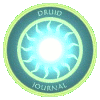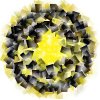Lughnasadh (pronounced lune-ah-sah) was a summer festival of the ancient Celts, celebrated around August 1. My understanding is that it is known that it was celebrated at either the full moon or the new moon closest to the midpoint between the summer solstice and the autumnal equinox. Since the midpoint is on August 6th, that means that this year, Lughnasadh falls on either July 25 (the new moon) or August 9 (the full moon). We celebrated the new moon this year; for the reason why, see the footnote below.
 Legend has it that the god Lugh established the holiday in honor of his mother, Tailtiu. Traditionally, it was celebrated with trade festivals, fairs, and bonfires. In the modern Druid Revival tradition, Lughnasadh is the midpoint between Midsummer and the fall equinox, one of the eight primary holidays of the Sun Path.
Legend has it that the god Lugh established the holiday in honor of his mother, Tailtiu. Traditionally, it was celebrated with trade festivals, fairs, and bonfires. In the modern Druid Revival tradition, Lughnasadh is the midpoint between Midsummer and the fall equinox, one of the eight primary holidays of the Sun Path.
For some reason, the company I work for, which builds dictation software, has not yet established Lughnasadh as a company holiday. So we decided to celebrate on Sunday, the 23rd, instead.
In John Michael Greer‘s “Druidry Handbook“, he describes a ritual that members of the AODA can use at Lughnasadh. We decided to adapt this for our family. The AODA ritual is quite lovely and has some beautiful, thoughtful passages concerning the turning of the year, the bounty of the Earth’s harvest, and the eternal cycle of rebirth. I practiced the ritual as often as I could, with and without the children, and studied the words carefully. When Lughnasadh came around, I had committed nearly 10% of the ritual to memory. However, bringing a crib sheet into the forest was out of the question; gods and esoteric forces would simply laugh or leave in disgust if I were standing there fumbling around with notes. So I was a little apprehensive as we hopped into the car to head for the local park.
We live near the Holyoke Range, an east-west line of mountains (one of the few east-west in the United States) that has stood against 300 million years of rain, floods, glaciers, and quarrying. They’re not as tall as they once were — your ears don’t even pop as you go over them — but they are comely. We parked at the visitors center between Bald Mountain and Mt. Norwottuck, and hiked a little ways into the woods of oak, pine, maple, and birch. For some reason — possibly because of the strange wet, hot weather we’ve had — the oak trees were already dropping their acorns, even though most of them were only half-formed. It had just rained, and the air was heavy and buggy. We found a disused path and set up for the ritual under some birch trees. A pillow-sized rock was dragged into the middle of the path to serve as an altar. On it, to represent the four elements, we placed a small bowl of water, a paper lantern my daughter made at school, a fallen leaf, and a stone. Now there was no more room on the altar, so on either side of it we placed a loaf of freshly baked barley bread and a mug of water.
I opened the sacred grove by proclaiming peace to the four quarters, and leading the family in purifying the grove with the four elements. The children were absolutely fascinated. At least, three of them were. The youngest, who is almost two, quickly became distracted and tried to experience nature in the way a two year-old should: by smearing herself with it. But the other three, aged seven, five, and three, were just the right ages to feel the power of the ritual most strongly. I think they experienced the ritual’s power as drama — a play in which the participants are the audience.
Soon, what little I remembered of the ritual was wiped away my nervousness. But when the head fails, the heart must serve. I went forward with my gut leading the way, and things went well enough. I cannot say that I or anyone else felt the special tingling in the air that signals the presence of the divine; supposedly this comes with practice. But we commemorated the season and gave thanks to the earth and the sun, which was the main point. We lifted the mug of water and took the ceremonial sips (my two-year-old went last, which was good, because she gulped it all down) and closed the sacred grove (I completely forgot the closing ceremony, and had to make one up). And then we went to a picnic table in an area somewhat less buggy and had a fantastic lunch of trail mix and barley bread with strawberry jam and almond butter, almost all of it homemade.
Reactions from the family were mostly positive, although my wife admitted that she was constantly wondering if anyone would come by and surprise us in the middle of the rite.
As we were leaving, my five-year-old daughter said, “Daddy, I’m going to hold onto these acorns, OK?” She showed me three stunted acorns in her hand, cradled there like precious jewels. “I’ll give them back to the earth when I’m done with them.”

Footnote: Why did we celebrate on the new moon? For the following reasons: (a) according to Ellis, the Celts believed that it was auspicious to begin endeavors as the moon was waxing, and especially on the day of the new moon; (b) probably because of this, I read the Wikipedia article on Lughnasadh and misread “full moon” as “new moon”. Only TODAY when I went back to look at the article again did I see “full moon”. But (c) according to the Wikipedia article on the Coligny calendar, it’s up for debate whether Celtic months began on the full or new moon; and frankly the new moon makes a lot more sense in light of (a). So I’m not sure what we’ll do in the future, but there you have it. Confusing enough?
Update August 1st: Jason Pitzl-Waters at The Wild Hunt has a neat posting with a collection of nice quotations, some good seeds for meditation.





Leave a comment